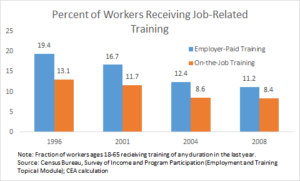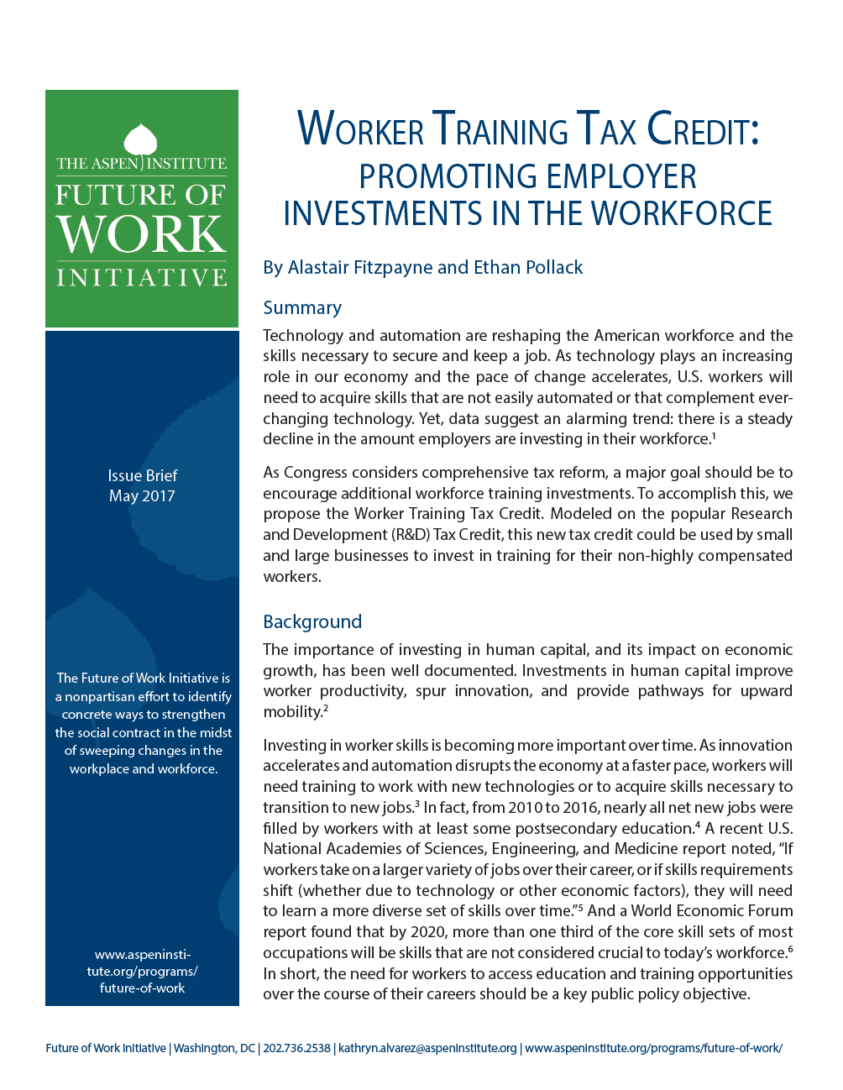This issue brief has been updated in August 2018 to include economic modeling.
SUMMARY
Technology and automation are reshaping the American workforce and the skills necessary to secure and keep a job. As technology plays an increasing role in our economy and the pace of change accelerates, U.S. workers will need to acquire skills that are not easily automated or that complement ever-changing technology. Yet, data suggest an alarming trend: there is a steady decline in the amount employers are investing in their workforce.[1]
As Congress considers comprehensive tax reform, a major goal should be to encourage additional workforce training investments. To accomplish this, we propose the Worker Training Tax Credit. Modeled on the popular Research and Development (R&D) Tax Credit, this new tax credit could be used by small and large businesses to invest in training for their low- and middle-income workers.
BACKGROUND
The importance of investing in human capital, and its impact on economic growth, has been well documented. Investments in human capital improve worker productivity, spur innovation, and provide pathways for upward mobility.[2]
Investing in worker skills is becoming more important over time. As innovation accelerates and automation disrupts the economy at a faster pace, workers will need training to work with new technologies or to acquire skills necessary to transition to new jobs.[3] In fact, from 2010 to 2016, nearly all net new jobs were filled by workers with at least some postsecondary education.[4] A recent U.S. National Academies of Sciences, Engineering, and Medicine report noted, “If workers take on a larger variety of jobs over their career, or if skills requirements shift (whether due to technology or other economic factors), they will need to learn a more diverse set of skills over time.”[5] And a World Economic Forum report found that by 2020, more than one third of the core skill sets of most occupations will be skills that are not considered crucial to today’s workforce.[6] In short, the need for workers to access education and training opportunities over the course of their careers should be a key public policy objective.
Many in the business community have recognized the need to increase investments to improve worker skills. Corporate leaders, including JPMorgan Chase CEO Jamie Dimon, IBM CEO Ginni Rometty, General Electric CEO Jeffrey Immelt, and Dow Chemical CEO Andrew Liveris have recently called for additional investments in worker training.[7]
Unfortunately, based on the data available, businesses have been investing less in their workers, not more. From 1996 to 2008, the percentage of workers receiving employer-sponsored or on-the-job training fell 42 percent and 36 percent, respectively (see chart below).[8] This decline was widespread across industries, occupations, and demographic groups.[9] Between 2003 and 2013, the number of formal programs that combine on-the-job learning with mentorships and classroom education – generally considered to be the most effective programs – fell 40 percent.[10]

While business investment in training has fallen, the public sector has not made up the difference. As a share of Gross Domestic Product (GDP), government spending on training and other programs to help workers navigate job transitions is now just 0.1 percent of GDP, lower than all other OECD countries except for Mexico and Chile and less than half of what it was 30 years ago.[11]
In part, the decline in employer-provided training can be explained by the changing nature of work and specifically, the changes in the employer-employee relationship. A generation ago, when many employees worked at the same company for their entire careers, an investment in worker training would benefit the worker and the company making the investment. As we have discussed in other briefs, workers of all ages are less likely to stay with firms for an extended period of time, and, as the Economist recently noted, “the single, stable career has gone the way of the Rolodex.”[12] The most recent job tenure data suggests that the average middle-aged male worker is now staying in a job for just over eight years, down from nearly thirteen years in 1983.[13] Fearing that workers will take their new skills to other employers, companies have responded by reducing their investments in training and skill development.
This trend exposes a market failure. Because the benefits of training reside primarily with the worker rather than with the business, there will always be a portion of the investment that benefits the overall economy but not the business itself. The result is less investment in training at the same time as the economy requires a more highly-skilled workforce.[14] This underinvestment justifies public policies to make workforce investments less costly and more attractive to employers.
Moreover, many low- and middle-wage workers do not benefit from existing training investments because businesses disproportionately direct training expenditures to the highest-paid and highest-educated workers.[15] A report from the Hitachi Foundation explains that training investments are often managed as worker benefits, which are also skewed towards higher-paid workers.[16] This skewed distribution suggests that any policy solution to the training disinvestment problem should target low- and middle-wage workers.
PROPOSAL: THE WORKER TRAINING TAX CREDIT
To address the decline in employer-provided worker training, we propose a business tax credit to offset a portion of the cost of new training activities for non-highly compensated workers. The Worker Training Tax Credit would mirror the policy design of the popular R&D Tax Credit. Businesses would establish a base expenditure level for qualified training expenses, which would be determined by averaging the amounts spent in each of the three years prior to the current tax year.[17] The value of the tax credit would be 20% of the difference between the current year qualified training expenditure and the base expenditure level. The credit would only cover training for non-highly compensated workers (less than $120,000 per year), the standard currently used in the Internal Revenue Code.[18]
Eligible training activities include employer-provided training that leads to an industry-recognized credential.[19] The credit could also be used to offset the cost of employer spending on training programs authorized under the Workforce Innovation and Opportunity Act.[20] There may be examples of employer-provided training that do not result in a recognized credential for the employee but is beneficial to the company and the employee. We would encourage policymakers to explore expanding the universe of eligible expenses to cover additional forms of training even if a credential is not the end result of the training.
Finally, in order to incentivize both small and large employers, our proposal borrows from the recent modification to the R&D credit that allows small and new businesses to access the credit.[21] First, small businesses with gross receipts under $5 million in the taxable year and no older than five years would be allowed to use the Worker Training Tax Credit against their payroll tax liability. Small businesses could take this payroll tax credit up to five times, but the overall credit amount is capped at $250,000 in a given tax year.[22] Second, small businesses would be able to use the Worker Training Tax Credit against the Alternative Minimum Tax.
EXAMPLES OF TRAINING TAX INCENTIVES
There are interesting examples of states, including Connecticut, Georgia, Kentucky, Mississippi, Rhode Island, and Virginia, who have provided businesses with tax incentives for training investments. These incentives range between 5 percent and 50 percent of training expenses.[23]
Worker training tax incentives can also be found internationally. For example, Austria provides a 120 percent business deduction for training expenses, as well as a 6 percent credit for companies that aren’t profitable enough to benefit from the deduction. France provides a business credit for entrepreneurs equal to the number of training hours multiplied by the minimum wage.
The European Union’s European Centre for the Development of Vocational Training looked at training tax incentives across the European continent and found that these policies encouraged job training and required less administrative overhead than government programs.[24] Its report did caution that these incentives may subsidize training activities that would have otherwise been done anyway, and it recommends that incentives target populations that don’t already have access to training. We believe that our policy design addresses these two concerns.
In the United States, two relevant training tax incentives were recently proposed. Representatives Pete Aguilar (D-CA) and Frank LoBiondo (R-NJ) introduced the On-the-Job Training Tax Credit Act of 2015, which would provide companies with 500 or fewer full-time employees a 50 percent tax credit to offset on-the-job employee training, up to $5,000.[25] And Representative Brenda Lawrence (D-MI) introduced the Promote Workforce Development for the Advancement of Manufacturers Act of 2017, which would allow manufacturing businesses to take a 20% credit for training expenses that exceed 50% of average over past 3 years.[26]
[1]
While there is sufficient employee data to determine that training investments have fallen, the federal government has not surveyed employers since 1995 (in the now-discontinued Survey of Employer-Provided Training). Employer data is important to better understand types of training provided and levels of investment. In Toward a New Capitalism, we recommend a new, regular employer survey of training practices, including informal training. http://www.aspeninstitute.org/wp-content/uploads/2017/05/New_Capitalism_Policy_Agenda.pdf
[2] Mankiw, Romer, and Weil 1992. “A Contribution to the Empirics of Economic Growth.” Quarterly Journal of Economics. (1992) 107 (2): 407-437. http://eml.berkeley.edu/~dromer/papers/MRW_QJE1992.pdf
Romer 1990. “Human Capital And Growth: Theory and Evidence.” Carnegie-Rochester Conference Series on Public Policy, 1990, vol. 32, issue 1, pages 251-286. http://www.sciencedirect.com/science/article/pii/016722319090028J
Lucas 1988. “On the Mechanics of Economic Development.” Journal of Monetary Economics 22 (1988) 3-42. http://www.parisschoolofeconomics.eu/docs/darcillon-thibault/lucasmechanicseconomicgrowth.pdf
[3] Acemoglu and Pischke 1999. “Beyond Becker: Training in Imperfect Labour Markets.” The Economic Journal 53 (453) (1999): F112–F142. https://economics.mit.edu/files/3810
Brynjolfsson and McAfee 2012. “Thriving in the Automated Economy.” World Future Society. http://ebusiness.mit.edu/erik/MA2012_Brynjolfsson_McAfee.pdf
[4] Carnevale, Jayasundera, and Gulish 2016. “America’s Divided Recovery: College Haves and Have-Nots.” Georgetown Center on Education and the Workforce. https://cew.georgetown.edu/wp-content/uploads/Americas-Divided-Recovery-web.pdf
[5] National Academies of Sciences, Engineering, and Medicine 2017. “Information Technology and the U.S. Workforce: Where Are We and Where Do We Go from Here?” https://www.nap.edu/catalog/24649/information-technology-and-the-us-workforce-where-are-we-and
[6] World Economic Forum 2016. “The Future of Jobs: Employment, Skills and Workforce Strategy for the Fourth Industrial Revolution.” January. http://www3.weforum.org/docs/WEF_FOJ_Executive_Summary_Jobs.pdf
[7] Dimon 2017. “2016 Letter to Shareholders.” JP Morgan Chase. April 4. https://www.jpmorganchase.com/corporate/investor-relations/document/ar2016-ceolettershareholders.pdf
Rometty 2016. “IBM CEO Ginni Rometty’s Letter to the U.S. President-Elect.” International Business Machines Corporation. November 15. https://www.ibm.com/blogs/policy/ibm-ceo-ginni-romettys-letter-u-s-president-elect/
Immelt 2017. “Competing For the World.” General Electric. May 4. http://www.gereports.com/competing-for-the-world/
Cohen 2017. “Jobless Rate at 10-Year Low as Hiring Grows and Wages Rise.” The New York Times. May 5. https://www.nytimes.com/2017/05/05/business/economy/jobs-report-unemployment.html
[8] Council of Economic Advisors 2015. “Economic Report of the President: 2015.” https://obamawhitehouse.archives.gov/sites/default/files/docs/cea_2015_erp_complete.pdf
[9] Waddoups 2016. “Did Employers in the United States Back Away from Skills Training during the Early 2000s?” ILR Review March 2016 vol. 69 no. 2 405-434. http://ilr.sagepub.com/content/69/2/405
[10] Weber 2014. “Apprenticeships Help Close the Skills Gap. So Why Are They in Decline?” Wall Street Journal. April 27. http://www.wsj.com/articles/SB10001424052702303978304579473501943642612
[11] Executive Office of the President 2016. “Artificial Intelligence, Automation, and the Economy.” December. https://obamawhitehouse.archives.gov/sites/whitehouse.gov/files/documents/Artificial-Intelligence-Automation-Economy.PDF
[12] The Economist 2017. “Equipping people to stay ahead of technological change.” January 14. http://www.economist.com/news/leaders/21714341-it-easy-say-people-need-keep-learning-throughout-their-careers-practicalities
[13] Bureau of Labor Statistics 2004. “Employee Tenure in 2004.” September 21. https://www.bls.gov/news.release/history/tenure_09212004.txt; Bureau of Labor Statistics 2016. “Employee Tenure in 2016.” September 22. https://www.bls.gov/news.release/archives/tenure_09222016.htm
This trend also applies to female workers, though it is masked by a separate, unrelated trend: childbirth is less disruptive to careers than it used to be, leading to greater labor force attachment among mothers. See Hollister and Smith 2014: http://journals.sagepub.com/doi/abs/10.1177/0003122413514584
[14] Lynch 2005. “Development Intermediaries and the Training of Low-Wage Workers.” National Bureau of Economic Research. http://www.nber.org/chapters/c9959
[15] Lerman, McKernan, and Riegg 2004. “The Scope of Employer-Provided Training in the United States: Who, What, Where, and How Much?” In Job Training Policy in the United States, Christopher J. O’Leary, Robert A. Straits, and Stephen A. Wandner, eds. Kalamazoo, MI: W.E. Upjohn Institute, pp. 211-244. http://research.upjohn.org/cgi/viewcontent.cgi?article=1175&context=up_bookchapters
[16] Levine, Popovich, and Strong 2013. “Doing Well or Doing Good: Pioneer Employers Discover Profits and Deliver Opportunity for Frontline Workers.” The Hitachi Foundation. September. http://www.hitachifoundation.org/storage/documents/DWDG_Web_Final.pdf
[17] Adjusted for inflation (CPI-U)
[18] This concept is found in Section 414(q) of the federal tax code. It was set at $120,000 in total compensation in 2016. https://www.irs.gov/retirement-plans/plan-participant-employee/definitions
[19] Section 3(52) of Workforce Innovation and Opportunity Act defines an industry-recognized credential as consisting of “an industry-recognized certificate or certification, a certificate of completion of an apprenticeship, a license recognized by the State involved or Federal Government, or an associate or baccalaureate degree.”
[20] Section 122(a)(2) of the Workforce Innovation and Opportunity Act defines an eligible training provider as (A) an institution of higher education that provides a program that leads to a recognized postsecondary credential; (B) an entity that carries out apprenticeship programs; or (C) another public or private provider of a program of training services, which may include joint labor-management organizations, and eligible providers of adult education and literacy activities if such activities are provided in combination with occupational skills training.
[21] Innovators Job Creation Act of 2015, sponsored by Sens. Roberts, Coons, and Schumer https://www.coons.senate.gov/newsroom/press-releases/senator-coons-r-and-d-provisions-included-in-year-end-tax-extenders-bill
[22] This provision should have no impact on the Social Security trust fund or individual worker contributions.
[23] Connecticut: Credit of 5% of all expenses incurred for the enhancement of human capital.
Georgia: Tax credit of 50% of a company’s direct training expenses, with up to $500 credit per full-time employee, per training program. Maximum annual credit per employee of $1,250.
Kentucky: Tax credit of 50% of eligible training.
Mississippi: Tax credit of 50% of costs for training an employee, not to exceed $2,500 per employee per year.
Rhode Island: Tax credit of 50% of training expenses for all employees, capped at $5,000 per employee.
Virginia: Tax credit of 30% of training costs (if through community college) or $200 annually (if through private schooling) for employers who participate in worker retraining efforts.
An evaluation by Connecticut’s Department of Economic and Community Development found that the credit “produces modest and positive benefits… [including] cumulative productivity gains to firms making investment in human capital.” Department of Economic and Community Development 2014. “An Analysis of Connecticut’s Tax Credit and Abatement Programs.” State of Connecticut. September. http://www.ct.gov/ecd/lib/ecd/decd_sb_501_sec_27_report_revised_2013_final.pdf
[24] Cedefop Panorama Series 2009. “Using Tax Incentives to Promote Education and Training.” European Centre for the Development of Vocational Training, Office for Official Publications of the European Committees. http://www.cedefop.europa.eu/en/publications-and-resources/publications/5180
[25] Companies with 500 or fewer full-time employees that also participate in on-the-job employee training would receive the lesser of the following as a tax credit: 50 percent of all expenditures for the job training program or $5,000. Representative Aguilar introduced the bill on May 19, 2015 to the House. https://www.congress.gov/bill/114th-congress/house-bill/2431/actions
[26] Representative Lawrence introduced the Promote Workforce Development for the Advancement of Manufacturers Act of 2017 on January 10, 2017 to the House. https://www.congress.gov/bill/115th-congress/house-bill/419


